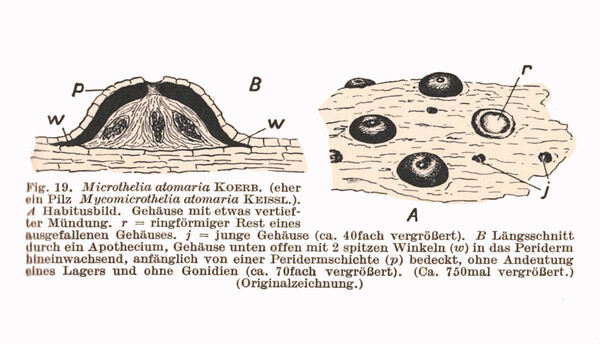Mycomicrothelia melanospora (Hepp) D. Hawksw.
Lichenologist, 14: 134, 1982. Basionym: Pyrenula melanospora Hepp - Flecht. Eur.: nr. 710, 1860.
Synonyms: Microthelia atomaria auct.; Microthelia koerberi Trevis.; Verrucaria micula var. cinereolutescens Garov.
Distribution: N - VG, Piem (Isocrono & al. 2004).
Description: Thallus crustose, fully endosubstratic and very poorly evident, most probably not lichenized. Perithecia black, 0.15-0.25(-0.3) mm across, projecting only with the ostiole, with a dark brown, mainly 5-15 µm thick involucrellum reacting K+ olive-green, extending laterally and forming a distinct, 30-60 µm wide, black fringe around the perithecium, formed of incorporated bark cells and radially oriented, 2-3 µm thick, rather uneven, irregularly branched, smooth-walled cells. Exciple 5-10 µm thick, composed of 2-5, 2-3 µm thick, uneven, ± smooth-walled wide layers of interwoven, compacted, brown hyphae reacting K+ olivaceous green, continuing below the centrum at maturity and pigmented throughout. Hamathecium of branched and anastomosing, persistent, filiform, numerous, 2-3 µm thick pseudoparaphyses; hymenial gel I-. Asci 8-spored, broadly clavate, with two functional wall layers, fissitunicate, with an internal apical beak, K/I-. Ascospores, 1-septate, weakly constricted at septum, brown, ellipsoid, the cells more or less equal in size, the ends rounded, (12.5-)13.5-15.5(-17) x (6-)6.5-7.5(-8) µm, the wall warted, with a c. 1 µm thick gelatinous sheath swelling in K. Pycnidia almost always present, scattered, black, ovoid but vertically compressed, 50-75(-l00) µm across, with an involucrellum-like structure in upper part, the wall continuous below the pycnidial cavity, mainly 3-8 µm thick (but to 15-18 µm thick near the ostiole), brown, K+ olivaceous green, formed of 1-3 layers of compacted interwoven hyphae. Conidiogenous cells arising from the inner wall, lacking distinct conidiophores but a few subhyaline pseudoparenchymatous cells often present, enteroblastic, acrogenous, short-ampulliform to almost subcylindrical, phialidic. Conidia arising singly, broadly cylindrical to elongate-ellipsoid, at first simple and hyaline, but becoming 1 -septate and olivaceous brown to dark brown before release, not constricted at septum, rounded at apex, the base rounded and truncated by a scar, smooth-walled, conspicuously 2-guttulate, 13-14.5 x 5.5-6.5 µm. Photobiont absent. Spot tests: K-, C-, KC-, P-, UV-. Chemistry: without lichen substances.Note: a non-lichenized species growing on the smooth bark of deciduous trees, especially of Mespilus germanica.
Growth form: Fungus
Substrata: bark
Reproductive strategy: mainly sexual
Pioneer species
Commonnes-rarity: (info)
Alpine belt: absent
Subalpine belt: absent
Oromediterranean belt: absent
Montane belt: very rare
Submediterranean belt: very rare
Padanian area: absent
Humid submediterranean belt: absent
Humid mediterranean belt: absent
Dry mediterranean belt: absent
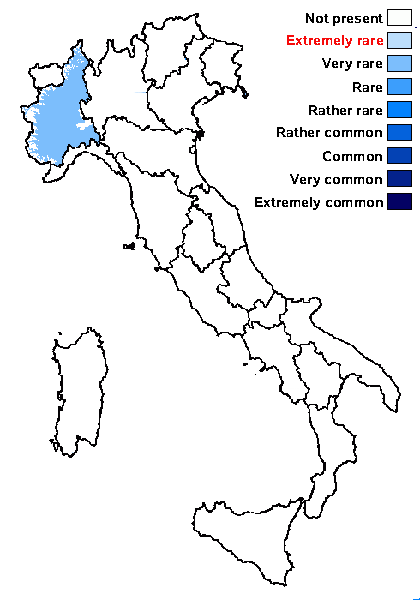
Predictive model
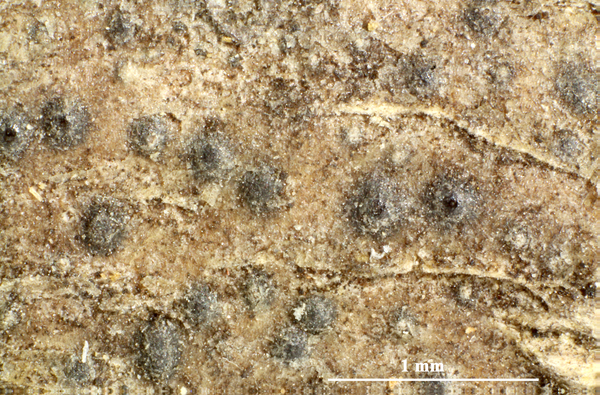

Felix Schumm - CC BY-SA 4.0
[Williams196], USA, Nebraska, Weeping Water, on bark of Zanthoxylum americanum. Leg. T. A. Williams (no 196), 29.11.1895, det. A. Aptroot. Distributed as 196 Pyrenula cinerella (Flotow) Willey in DECADES OF NORTH AMERICAN LICHENS BY C.E. CUMMINGS, T.A. WILLIAMS & A.H. SEYMOUR.
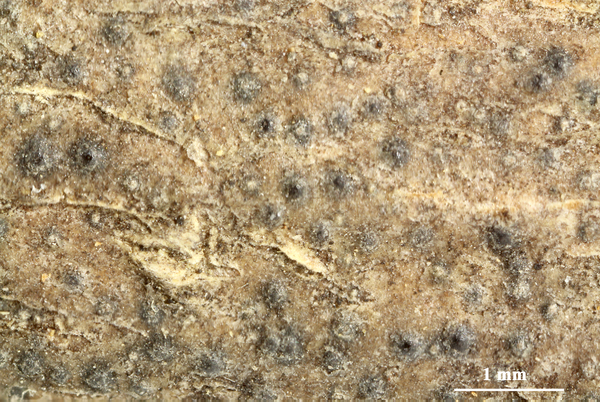

Felix Schumm - CC BY-SA 4.0
[Williams196], USA, Nebraska, Weeping Water, on bark of Zanthoxylum americanum. Leg. T. A. Williams (no 196), 29.11.1895, det. A. Aptroot. Distributed as 196 Pyrenula cinerella (Flotow) Willey in DECADES OF NORTH AMERICAN LICHENS BY C.E. CUMMINGS, T.A. WILLIAMS & A.H. SEYMOUR.
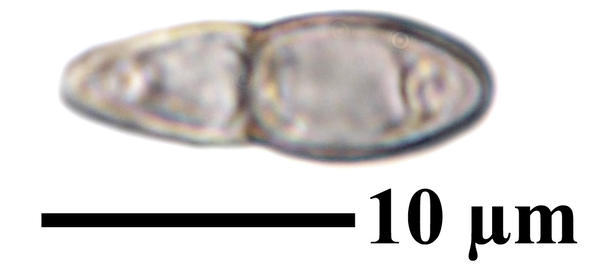

Felix Schumm - CC BY-SA 4.0
[Williams196], USA, Nebraska, Weeping Water, on bark of Zanthoxylum americanum. Leg. T. A. Williams (no 196), 29.11.1895, det. A. Aptroot. Distributed as 196 Pyrenula cinerella (Flotow) Willey in DECADES OF NORTH AMERICAN LICHENS BY C.E. CUMMINGS, T.A. WILLIAMS & A.H. SEYMOUR.
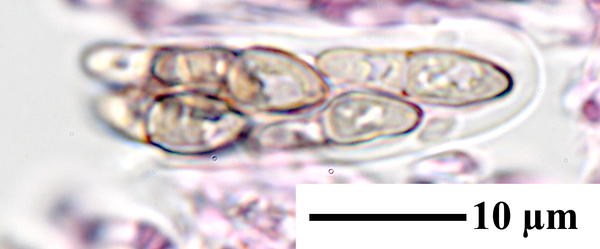

Felix Schumm - CC BY-SA 4.0
[Williams196], USA, Nebraska, Weeping Water, on bark of Zanthoxylum americanum. Leg. T. A. Williams (no 196), 29.11.1895, det. A. Aptroot. Distributed as 196 Pyrenula cinerella (Flotow) Willey in DECADES OF NORTH AMERICAN LICHENS BY C.E. CUMMINGS, T.A. WILLIAMS & A.H. SEYMOUR.


Felix Schumm - CC BY-SA 4.0
[Williams196], USA, Nebraska, Weeping Water, on bark of Zanthoxylum americanum. Leg. T. A. Williams (no 196), 29.11.1895, det. A. Aptroot. Distributed as 196 Pyrenula cinerella (Flotow) Willey in DECADES OF NORTH AMERICAN LICHENS BY C.E. CUMMINGS, T.A. WILLIAMS & A.H. SEYMOUR.


Felix Schumm - CC BY-SA 4.0
[Williams196], USA, Nebraska, Weeping Water, on bark of Zanthoxylum americanum. Leg. T. A. Williams (no 196), 29.11.1895, det. A. Aptroot. Distributed as 196 Pyrenula cinerella (Flotow) Willey in DECADES OF NORTH AMERICAN LICHENS BY C.E. CUMMINGS, T.A. WILLIAMS & A.H. SEYMOUR.
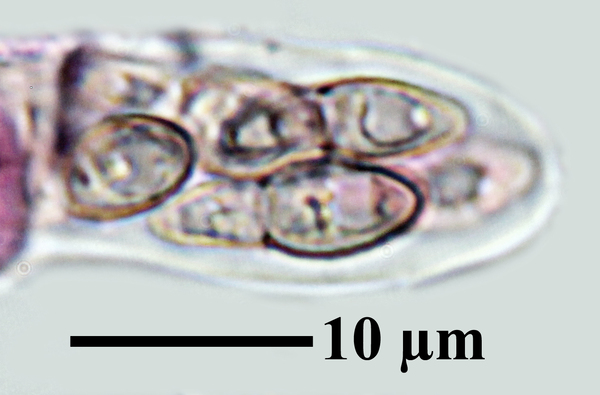

Felix Schumm - CC BY-SA 4.0
[Williams196], USA, Nebraska, Weeping Water, on bark of Zanthoxylum americanum. Leg. T. A. Williams (no 196), 29.11.1895, det. A. Aptroot. Distributed as 196 Pyrenula cinerella (Flotow) Willey in DECADES OF NORTH AMERICAN LICHENS BY C.E. CUMMINGS, T.A. WILLIAMS & A.H. SEYMOUR.
Growth form: Fungus
Substrata: bark
Reproductive strategy: mainly sexual
Pioneer species
Commonnes-rarity: (info)
Alpine belt: absent
Subalpine belt: absent
Oromediterranean belt: absent
Montane belt: very rare
Submediterranean belt: very rare
Padanian area: absent
Humid submediterranean belt: absent
Humid mediterranean belt: absent
Dry mediterranean belt: absent

Predictive model


Felix Schumm - CC BY-SA 4.0
[Williams196], USA, Nebraska, Weeping Water, on bark of Zanthoxylum americanum. Leg. T. A. Williams (no 196), 29.11.1895, det. A. Aptroot. Distributed as 196 Pyrenula cinerella (Flotow) Willey in DECADES OF NORTH AMERICAN LICHENS BY C.E. CUMMINGS, T.A. WILLIAMS & A.H. SEYMOUR.


Felix Schumm - CC BY-SA 4.0
[Williams196], USA, Nebraska, Weeping Water, on bark of Zanthoxylum americanum. Leg. T. A. Williams (no 196), 29.11.1895, det. A. Aptroot. Distributed as 196 Pyrenula cinerella (Flotow) Willey in DECADES OF NORTH AMERICAN LICHENS BY C.E. CUMMINGS, T.A. WILLIAMS & A.H. SEYMOUR.


Felix Schumm - CC BY-SA 4.0
[Williams196], USA, Nebraska, Weeping Water, on bark of Zanthoxylum americanum. Leg. T. A. Williams (no 196), 29.11.1895, det. A. Aptroot. Distributed as 196 Pyrenula cinerella (Flotow) Willey in DECADES OF NORTH AMERICAN LICHENS BY C.E. CUMMINGS, T.A. WILLIAMS & A.H. SEYMOUR.


Felix Schumm - CC BY-SA 4.0
[Williams196], USA, Nebraska, Weeping Water, on bark of Zanthoxylum americanum. Leg. T. A. Williams (no 196), 29.11.1895, det. A. Aptroot. Distributed as 196 Pyrenula cinerella (Flotow) Willey in DECADES OF NORTH AMERICAN LICHENS BY C.E. CUMMINGS, T.A. WILLIAMS & A.H. SEYMOUR.


Felix Schumm - CC BY-SA 4.0
[Williams196], USA, Nebraska, Weeping Water, on bark of Zanthoxylum americanum. Leg. T. A. Williams (no 196), 29.11.1895, det. A. Aptroot. Distributed as 196 Pyrenula cinerella (Flotow) Willey in DECADES OF NORTH AMERICAN LICHENS BY C.E. CUMMINGS, T.A. WILLIAMS & A.H. SEYMOUR.


Felix Schumm - CC BY-SA 4.0
[Williams196], USA, Nebraska, Weeping Water, on bark of Zanthoxylum americanum. Leg. T. A. Williams (no 196), 29.11.1895, det. A. Aptroot. Distributed as 196 Pyrenula cinerella (Flotow) Willey in DECADES OF NORTH AMERICAN LICHENS BY C.E. CUMMINGS, T.A. WILLIAMS & A.H. SEYMOUR.


 Index Fungorum
Index Fungorum
 GBIF
GBIF
